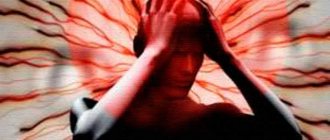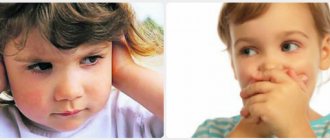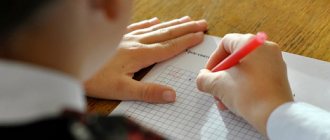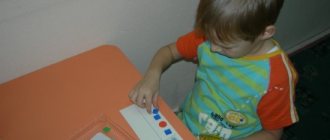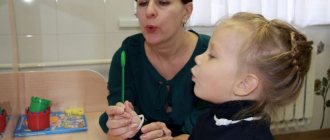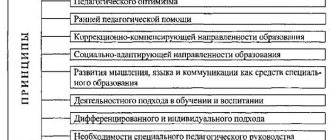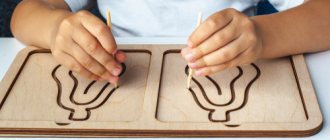Alalia what is it - symptoms in children, causes and treatment
Your child should have started talking a long time ago, but is stubbornly silent? This alarming symptom cannot be ignored. The cause of speech impairment in a child may be sensory or motor alalia.
This disease usually develops against the background of insufficient development of the speech center in the baby’s cerebral cortex. In order for a doctor to prescribe effective treatment for alalia in a baby, it is very important to recognize the pathology at an early stage.
Speech alalia is diagnosed in approximately 1% of preschool children and 0.2-0.6% of school-age children; in boys, its development is observed 2 times more often. A child with alalia needs psychological, medical and pedagogical intervention, which must necessarily be comprehensive, include drug therapy, as well as the development of mental functions, coherent speech, lexical-grammatical and phonetic-phonemic processes.
Causes
The following factors lead to the disease:
- Intrauterine hypoxia.
- Intrauterine TORCH infection.
- Constant threat of miscarriage.
- Toxicosis.
- Injuries during pregnancy.
- Chronic somatic disease of a pregnant woman - low or high blood pressure, pulmonary, heart failure.
Most often, alalia is provoked by complicated childbirth or perinatal pathology. In some situations, the disease develops in the case of asphyxia of the newborn, intracranial injury to the baby during rapid or emergency childbirth, as well as when using various instruments.
Motor alalia in children
Motor alalia in children manifests itself in their inability to pronounce words clearly. But in the vast majority of cases, children with this form of the disease are unable to speak at all. They are simply silent. Although here the perception of extraneous speech may not be impaired.
Motor alalia is the child’s inability to repeat the pronunciation of a sound, syllable or word. The child understands all words and can show their meaning with gestures. But the pronunciation is missing. The reason is a disruption in the connection of the brain speech centers with the organs of the speech apparatus.
An even more severe form of the disorder is sensorimotor alalia. In this condition, the child does not understand foreign speech, does not have the ability to recognize it, and cannot speak. Sensorimotor alalia occurs in approximately 3.7% of all cases of the disease.
Symptoms
Sensorimotor alalia represents the immaturity of speech functionality at a fairly deep level. In most cases, it is possible to diagnose the problem in preschool age, when it is possible to correct its development and provide the child with a normal subsequent life.
The disease may be systemic or widespread. In other words, the violation affects all components of speech at once and manifests itself quite specifically.
There are several signs that become most typical for sensorimotor alalia:
- Minimum vocabulary.
- Late formation of speech functionality.
- Inarticulate pronunciation, problems with pronunciation.
- Problems of syllabic structure.
The pathology has a pronounced manifestation. The symptoms of the problem are represented by various manifestations. Among the main ones are:
- Problems with coordination.
- Fine motor defects.
- Awkwardness.
- Problems with self-care, such as buttoning buttons or tying shoelaces.
- Impaired attention, reaction, memory, concentration.
- Hyperactivity or inertia and increased fatigue depending on the child and the nature of the injury.
- Understanding someone else's speech, but not the ability to perform independent speech.
- Delay in the formation of speech skills.
- Inability to repeat after other people.
- Stuttering.
- Articulation problems.
- Small vocabulary.
Neurological manifestations can also be identified. This may be a lack of understanding of the addressed speech, high speech activity, but the baby speaks his “own” language, severe violations of phonemic hearing.
Sensory alalia in children
Sensory alalia in children manifests itself in the fact that the baby does not perceive extraneous speech. At the same time, he has speech disinhibition. It is difficult to interrupt the flow of speech in such a baby and make him hear what you are saying to him.
The cause of sensory alalia is the weakness of the speech analyzer in the cerebral hemispheres. The nerve impulse may reach it weakly or not at all. Damage to the nerve signal transmission pathways is observed.
Mixed alalia
The symptoms and treatment of mixed alalia are very serious. With this pathology, the entire sensorimotor area of the cerebral cortex is affected. Sick children not only do not understand what their parents say, but they also cannot speak. This form of pathology is the most difficult to treat, and even an integrated approach does not guarantee a positive prognosis.
The disease may appear gradually. If at 1.5-2 years the lack of coherent speech in a child does not cause strong concerns among parents, then the same defect at 3-4 years should alert you. Pathology has a direct effect on the cerebral cortex. For treatment to be as effective as possible, try to identify the disease at the earliest stage of development.
Alalia. A beautiful word. Probably, this could be the name of some delicate flower. Or a paradise island in the warm sea. Or a mysterious, alluring planet in the depths of space.
But in fact, alalia is a very dangerous disease that affects the brain of children and robs them of one of the greatest joys in the world - the joy of full communication.
The name “alalia” comes from the ancient Greek “lalia” - speech and the negation prefix “a”. This is underdevelopment or complete absence of speech in a child, which is the result of damage to the speech centers of the brain.
HOW TO RECOGNIZE ALALIA?
The most important symptom of this dangerous disease is the child’s lack of coherent speech. If at three or four years old your baby continues to sweetly babble, hum and make other sounds that so pleased and amused you when he was one and a half to two years old, this may be a symptom of alalia. And you urgently need to contact a specialist.
WHAT CAN CAUSE ALALIA?
The appearance of alalia in children is based on incorrect or incomplete formation of the brain centers responsible for the perception and reproduction of speech. The neurons from which these centers are built during the prenatal period and in the first years of life simply “do not mature” and stop in their development. This leads to the fact that the child is deprived of the opportunity to speak coherently and understand someone else’s speech.
It is necessary to remember: alalia is the result of a gross violation of the development of parts of the brain. It will not go away on its own. No attempts to teach an alalik child to speak, made at home, without contacting specialists, will yield positive results. No amount of perseverance, patience, or love will help a child without qualified guidance, without help and support from pediatricians, child psychologists, neuropsychologists, and speech therapists.
Pathologies in the development of the brain of children can be different. The disease can affect the fetus even at the stage of intrauterine development due to:
- - intrauterine infection,
- - hypoxia,
- - severe toxicosis, viral or chronic diseases of the pregnant woman,
- - mechanical injuries to the fetus.
THERE ARE THREATS TO NEWBORN HEALTH, THESE ARE:
- - premature birth,
- - umbilical cord asphyxia,
- - damage to the skull as a result of improper use of medical instruments during childbirth.
However, statistical data show that in the greatest number of cases, pathology of speech development in a child occurs between the ages of 1 and 3 years. In this case, the disease can be triggered by various factors, such as:
- - meningitis, encephalitis,
- - somatic diseases,
- - head injuries,
- - severe viral diseases,
- - rickets,
- - operations performed under anesthesia.
We must not forget about the hereditary predisposition to alalia.
WHAT TYPES OF ALALIA ARE THERE?
Depending on which area of the child’s brain is damaged, there are three main types of alalia: sensory, motor and mixed.
Sensory alalia develops when the part of the cerebral cortex that is responsible for analyzing speech is damaged. The child is unable to understand speech addressed to him and cannot compare the visual image of an object and its sound designation.
CHARACTERISTIC SYMPTOMS OF THIS TYPE OF ALALIA MAY BE:
- - disinhibition of speech: the child chatters incessantly, but it is impossible to understand what he is saying,
- - the child’s poor listening comprehension of other people’s speech,
- - pronouncing several words in a row as one,
- - substitution of letters and syllables when pronouncing even the simplest words,
- - increased activity and impulsiveness of the child, alternating with periods of isolation and depression,
- - the child’s inability to connect the visual image of an object with its verbal designation, name,
- - underdevelopment of intellectual functions.
Motor alalia occurs as a result of a violation of the development of Broca's center - a region of the brain that ensures the motor organization of speech and the normal functioning of the speech apparatus. With this type of alalia, the child understands speech addressed to him, but he himself is not able to fully master speech skills.
SYMPTOMS OF MOTOR ALALIA ARE:
- - very late - at four years and later - the formation of speech in a child,
- - the child’s poor vocabulary,
- - inability to construct sentences grammatically correctly: incorrect use of cases, genders, numbers,
- - inability to distinguish words that sound similar,
- - poor coordination of movements,
- - frequent periods of isolation, aggressiveness
- - inattention, accompanied by hyperactivity or, on the contrary, depression, passivity.
MIXED ALALIA IS THE MOST DANGEROUS DISEASE, SINCE IT IS CAUSED BY SIMULTANEOUS DAMAGE TO DIFFERENT AREAS OF THE BRAIN. IN THIS WAY, THE CHILD NOT ONLY DOES NOT UNDERSTAND THE SPEECH OF OTHER PEOPLE, BUT ALSO CANNOT SPEAK.
ALALIA CORRECTION
Treatment and correction of alalia is a complex process that requires a lot of time and effort. In this case, close interaction between doctors and parents is absolutely necessary.
It should be noted that since alalia is caused by disturbances in the development of areas of the brain, its treatment cannot be done without medication. Of course, only professional doctors can prescribe the use of appropriate medications.
However, treatment must necessarily include such types of therapy as:
- — developmental classes with a speech therapist,
- - microcurrent reflexology,
- - massotherapy
- — physiotherapy
In addition to specialists, parents also have a lot of work to do. At home, you must continue to work with your child using the methods developed together with doctors.
Only through joint efforts can you help a child suffering from this dangerous disease.
Treatment of alalia in children
Therapy for this disorder is based on test results and the degree of manifestation of symptoms, and therefore will be developed individually for each small patient. The most favorable age for treating alalia is considered to be 4 years old; it is during this period that the child shows the greatest interest in the world around him.
Common treatments include:
- Conducting therapeutic speech therapy facial massages. This method of treatment helps to tone and relax the facial muscles, which can reduce the manifestation of some symptoms;
- Courses with a speech therapist, which are often combined with taking medications. Classes with a doctor will be effective for all forms of the disease. The treatment regimen is drawn up for each child separately, taking into account the general state of health, age and degree of disorder. The task of a speech therapist is to develop speech ability, teach how to correctly pronounce words and construct phrases, and also increase vocabulary. Taking medications is aimed at improving the nutrition of the brain (a complete supply of vitamins and nutrients);
- Physiotherapy, the purpose of which is to influence certain areas of the brain with electrical impulses. This method of treatment does not harm health and is completely painless, so it can be performed on children under the age of one year.
If you carry out timely, and most importantly, well-chosen treatment, the child will get rid of all the symptoms of the disease or learn to control them. But the main thing is that he will be able to study at a comprehensive school and adapt to society.
Parental support plays an important role in therapy, since it is important for the child to know that his successes in treatment do not go unnoticed by those closest to him; this will provide an additional incentive for a speedy recovery, which further facilitates treatment.
Clinical picture and behavioral characteristics
In the absence of verbal communication with children or adults, the child experiences psychological discomfort. Children from a very early age use gestures to express their emotions and desires.
Gradually, they begin to connect speech to this, which becomes more complex as they grow older.
A child with alalia does not have this opportunity; it is difficult for him to explain what he wants from an adult. The degree of difficulty may vary, but there are three levels of underdevelopment of the speech apparatus:
- Complete lack of speech.
- There are initial signs of speech development. The baby has some words or sounds in its reserve and can make words from them, but such a reserve is extremely limited.
- There is an extended speech with fragments of weak development of the speech system. The vocabulary in this case is large, but the words are pronounced in a distorted way, and there are defects in the pronunciation of certain sounds.
These levels are not related to the child's age. At 5 years old he can be at the first level. These impairments inevitably affect oral speech and, later, the ability to write and read.
Children have difficulty remembering letters and numbers. They confuse them, interfere with each other. This further complicates the development of speech ability. The child understands everyday speech. It is simple for him and does not require grammatical rules.
The child can understand simple requests, such as closing the door or taking a book, based on the current situation. He understands that if the door to the room is closed, and his mother suddenly spoke about it, then some manipulations need to be done with it.
Intuitively, the baby will open the door. But whether he understands exactly the meaning of words at this moment depends on the severity of the disease. At difficult stages, he may not understand at all what adults tell him.
Alalia correction
Correction of alalia is carried out simultaneously with drug therapy, which is aimed at stimulating the maturation of brain structures, as well as physiotherapy (magnetotherapy, laser therapy, hydrotherapy, electrophoresis, electropuncture). With alalia, it is very important to work on the development of motor skills - manual and general, as well as mental functions (attention, memory, thinking).
Considering the fact that the violation is systemic in nature, classes to correct alalia involve working on all aspects of speech. In particular, with motor alalia in children, speech activity is stimulated, work is done on sound pronunciation, vocabulary formation, development of coherent speech, and grammatical design of statements. Speech therapy classes for alalia necessarily include speech therapy massage and logorhythmics.
With sensory alalia, the tasks are to master the distinction between non-speech and speech sounds, the differentiation of words, their correlation with specific objects and actions, the understanding of phrases and speech instructions, and the grammatical structure of speech. As the vocabulary accumulates, subtle acoustic differentiations and phonemic perception are formed, the development of the child’s own speech becomes possible.
For various forms of alalia, it is recommended that children learn to read and write at a relatively early age, since writing and reading allow them to better consolidate the learned material, as well as control oral speech.
Diagnostics
To make a diagnosis, additional examinations may be required:
- MRI of the brain.
- X-ray of the head. Electroencephalography.
- Neurosonography
Diagnostic tests allow us to understand how much the brain is affected. This is the only way to determine the course of treatment and its main stages. Parents will also have to visit an otolaryngologist and speech therapist. Based on a set of studies, a diagnosis is established.
Remember that alalia does not contribute to a decrease in hearing and intelligence. However, visiting an otolaryngologist, performing an otoscopy and audiometry will help rule out other possible disorders that may also affect speech impairment.
Specialists additionally carry out differential diagnostics, which helps to evaluate a number of significant criteria and accurately determine the form of alalia. The following skills are assessed:
- speech understanding and listening comprehension;
- ability to repeat sounds and individual words;
- the child’s reactions in the form of gestures and facial expressions to spoken speech;
- development of other communication skills;
- dynamics of speech development over time.
It is important to undergo a full examination in order to more accurately select a correction program for the child and treatment format.
Classes at the clinic
Alalia can be cured in specialized clinics. This method is one of the most effective, since children are trained using a specially developed method:
- development of cognitive function;
- formation of morphological and sound analysis;
- restoration of semantic aspects of speech, etc.
In such clinics you can get advice from a speech therapist, neurologist, psychoneurologist, or psychiatrist. They will be able to give advice on treatment, nutrition and diet of the child during illness. In this case, meals should be fractional and correct; the child needs to eat more vegetables and fruits, as well as lean meats: chicken, turkey, rabbit, beef.
Prevention
In order for your child to be healthy, prevention must begin even before birth. The expectant mother must be very careful and follow all doctor's recommendations to avoid serious injuries during pregnancy and childbirth.
It is worth following these tips:
- take medications and vitamins prescribed by your doctor;
- visit a gynecologist frequently during pregnancy;
- be attentive to your health and the health of your baby;
- if the due date has passed, then in no case should stimulation be postponed.
But that’s not all, since after the birth of a child, it is necessary to create favorable conditions for its development. Follow these simple rules, and your child will not lag behind other children in development, and you will not have any reason to worry.
